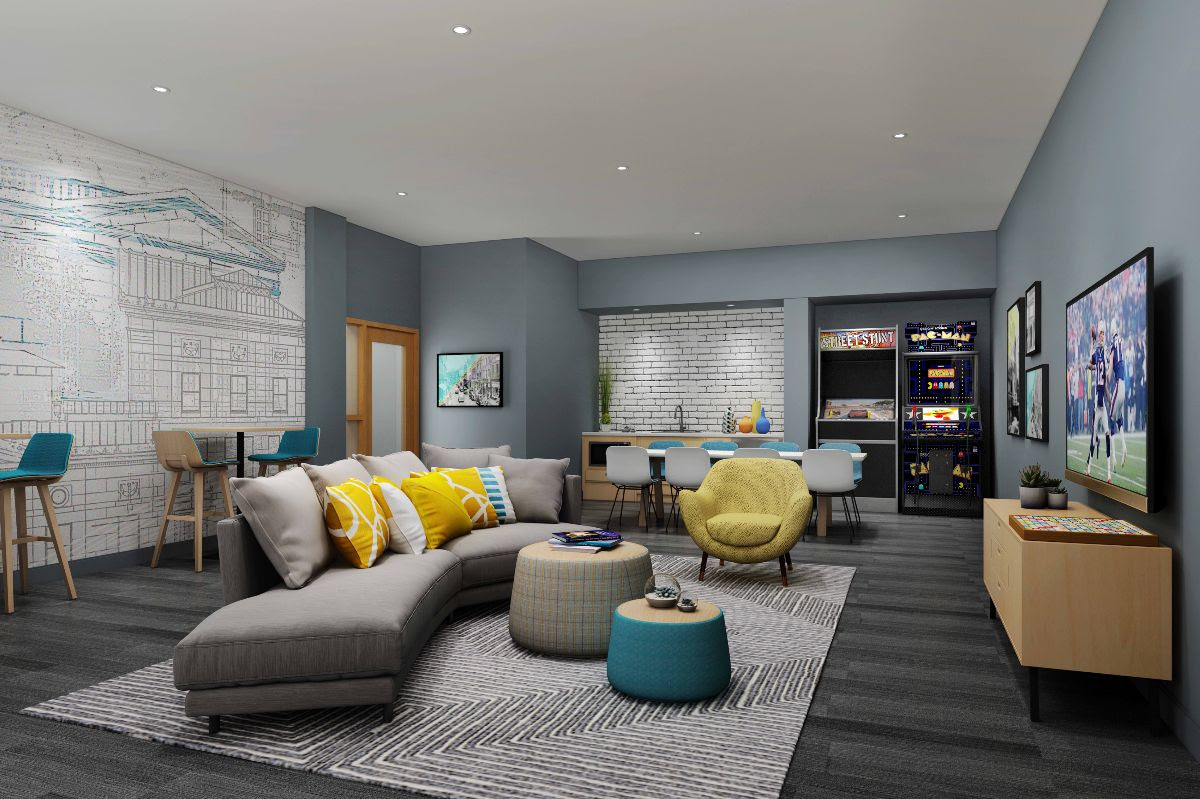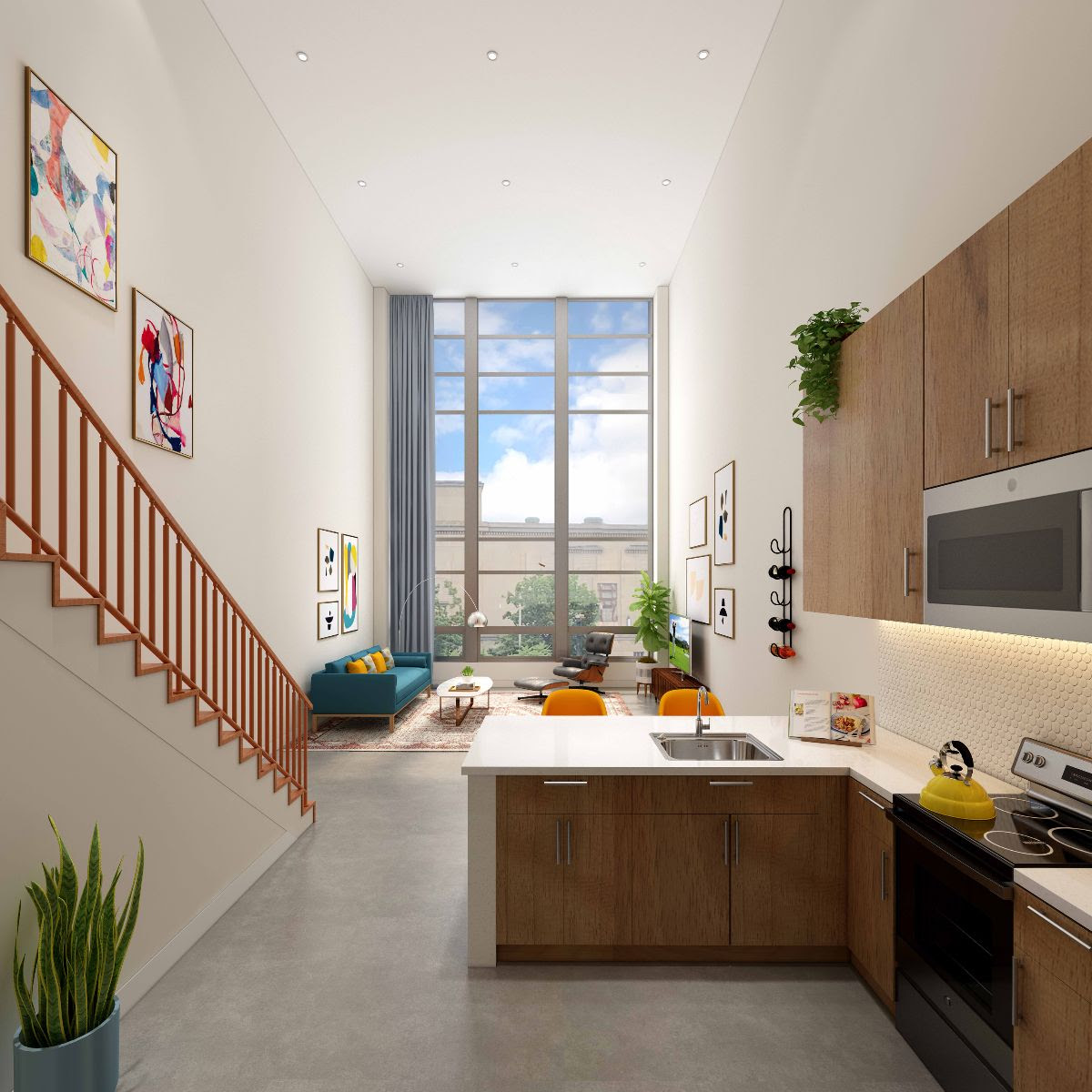|


 

The Worcester County Courthouse has been a regional landmark since it first opened in 1843 as an imposing two-story granite building with a single courtroom. It expanded over the next century with multiple architecturally distinct additions and annexes – first in 1878, then again in 1898, and finally in 1955. By the time the courthouse fell out of use in 2008, this set of buildings became a complicated warren of offices, hallways, and historically landmarked monumental spaces. Restoring the property and converting it into a functional multifamily community, now known as Courthouse Lofts, required an unusually intricate design vision.
 Rendering Credit: Wall3D Rendering Credit: Wall3D
When The Architectural Team (TAT) was selected as architect and interior designer, that vision came into focus with a simple statement of intent: Honor the historic spaces while giving them contemporary utility. Working within the confines of a landmarked property helped to set certain basic parameters, and the design team was required to preserve courtrooms from each building addition, and to restore main entry spaces, circulation corridors, stairs, ceilings, flooring, stained glass in the lobby, and spatial volumes that had been left derelict and abandoned for more than 12 years. In addition, the project team created a setting for an exciting museum space dedicated to the history of pioneering Black cyclist and Worcester resident Major Taylor.
 Court Room Before/After Court Room Before/After
Rendering Credit: Wall3D
Following these substantial efforts, the primary interior design challenge became one of scale and character: In such a large complex with grand balustrades, millwork, and other historic detailing, how can you create spaces that feel intimate, welcoming, and functional in a modern living environment?
For common areas, TAT’s design solution focused on introducing dedicated zones that break up large spaces and form discrete amenities. The monumental domed courtroom is now a resident club room with a variety of distinct uses, including a shared kitchen built into a former witness stand, media areas in the plinths that once served as seating for the courtroom audience, and a restored holding area behind the jury box. In the center of the space, lounge zones and remote work settings add functionality and reduce the room’s perceptual scale. Confined to a limited number of changes in this historic space, the design team delineated these different zones through the strategic use of millwork and FF&E rather than any major structural interventions.
In some instances, the design team built on a space’s distinct architectural character to add contemporary functionality that feels era-appropriate. The new mailroom is located by a primary entrance in the 1950s addition. To play on this space’s classic midcentury character (think restored historic phone booths and rose-colored marble with original etched quotations), TAT’s designers added mail infrastructure rendered in walnut with clean modernist lines, using custom millwork to create a mailroom scene that looks as if it had always occupied this space.

Rendering Credit: Wall3D

Rendering Credit: Wall3D
For individual apartments, the design team took a different approach to the question of balancing old and new. The units themselves are remarkable: Out of 118 units, only two share the same floor plan. Ranging from studio lofts to large duplexes, the atypical nature of these spaces presented a challenge – many units incorporate a variety of historic elements such as original stairways and doorframes (some, like the one in the ClubRoom Lounge, were sealed but retained for historic purposes), courtroom doors, and intricate moldings, while other units feature midcentury curtainwall systems in need of historically matched replica replacements.
The design team chose to embrace the variety. A neutral palette helps fixtures and finishes work as well in a structure from the 1850s as they do in one from the 1950s: Medium wood tones and simple white cabinetry and backsplashes allow the rest of the architectural elements to play the central role in defining the units’ character. This ensures that every space will feel as unique and special as possible, while remaining highly functional.

Rendering Credit: Wall3D
What ultimately holds the exciting and complicated Courthouse Lofts conversion together, and ensures it stands as a coherent design vision, is a deep respect for the complex’s character and identity regardless of era. By honoring that spirit of the past, design teams can create new experiences for generations of end-users that will look beautiful, function flawlessly, and continue to tell a remarkable story.

Collaborators-
FF+E; Executive Furnishings, Inc.
Artwork; Grand Image
Custom Walk-off Mats; Mats, Inc.
Contractor; Tocci Building Corporation
Developer; Trinity Financial
Civil Engineer; Bohler Engineering
Landscape Architect; Deborah Myers Landscape Architecture
Structural Engineer; DM Berg Consultants
MEP Engineer; Petersen Engineering, Inc.
Building Envelope Consultant; Building Enclosure Associates, LLC


|






 Rendering Credit: Wall3D
Rendering Credit: Wall3D





